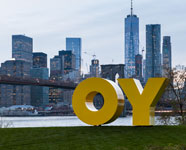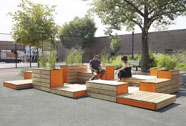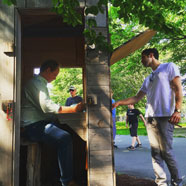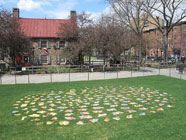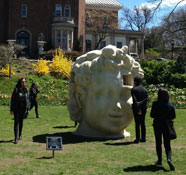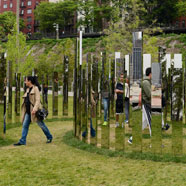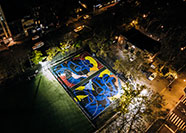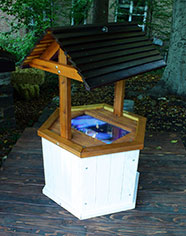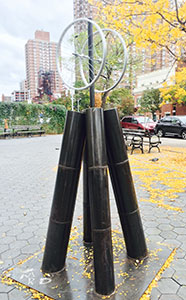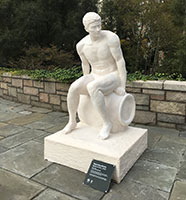Art in the Parks
Through collaborations with a diverse group of arts organizations and artists, Parks brings to the public both experimental and traditional art in many park locations. Please browse our list of current exhibits and our archives of past exhibits below. You can also see past grant opportunities or read more about the Art in the Parks Program.
Public Art Map and Guide
Find out which current exhibits are on display near you, and browse our permanent monument collection.
Search Current and Past Exhibits
2016
Brooklyn
Deborah Kass, OY/YO
November 11, 2015 to August, 2016
Brooklyn Bridge Park, Brooklyn
Map/Directions (in Google Maps)
Please note: This is a past exhibit that is no longer installed in the park.
Walking the line between respectful homage and brazen appropriation, Brooklyn-based artist Deborah Kass mimics and reworks the signature styles of iconic 20th century male artists —including Frank Stella, Andy Warhol, Jackson Pollock, Ed Ruscha, and Robert Indiana – often with a feminist twist. OY/YO is sourced from urban and Brooklyn slang, the statement “I am” in Spanish, and the popular Yiddish expression, as a riff on Ruscha’s iconic word paintings.
OY/YO has been a significant and reoccurring motif in Kass’ work since its first appearance in 2011, taking form in paintings, prints, and tabletop sculptures. Set alongside the iconic bridges of Brooklyn’s waterfront and visible to viewers from Manhattan, Brooklyn Bridge Park’s Main Street lawn is an apt location for a monumental installation of OY/YO. Similar to the City of New York’s “Leaving Brooklyn: Oy Vey!” sign at the Williamsburg Bridge and the “Leaving Brooklyn: Fuhgeddaboudit” sign on the BQE, OY/YO references Brooklyn’s ethnic communities with whimsy and warmth.
Commissioned by Two Trees and presented in partnership with Brooklyn Bridge Park, the work will be on view through August 2016 and is presented on the occasion of the artist’s exhibition No Kidding opening at Paul Kasmin Gallery in Chelsea December 9, 2015. For more information about this artwork, please visit the Brooklyn Bridge Park Conservancy’s website.
![]()
Michael Clyde Johnson, Untitled Benches, Patios, Planters in Arrangement (Parklet for Ennis Playground)
August 31, 2015 to August 30, 2016
Ennis Playground, Brooklyn
Map/Directions (in Google Maps)
Please note: This is a past exhibit that is no longer installed in the park.
As a parklet within a park, the goal of Untitled Benches, Patios, Planters in Arrangement (Parklet for Ennis Playground) is to provide additional public amenities to Ennis Playground, and by extension to the wider Gowanus neighborhood. These amenities are multi-faceted: the project includes three modular components – patios, benches, and planters – which, when combined, serve to create additional distinct lounge and play areas within the park. By extending the idea of a parklet – generally conceived as an extension of sidewalk space into the street to provide additional seating and green space – to encompass the extension of these same functions within an existing public space, Parklet for Ennis Playground serves to augment existing facilities.
This project was made possible with funding from Councilmember Brad Lander, in partnership with Arts Gowanus and the Old Stone House & Washington Park
![]()
The Poetry Society of New York, The Typewriter Project: The Subconscious of the City
June 11, 2016 to July 24, 2016
McCarren Park, Brooklyn
Map/Directions (in Google Maps)
Please note: This is a past exhibit that is no longer installed in the park.
The Typewriter Project: The Subconscious of the City is a booth outfitted with a vintage typewriter, 100-foot long paper scroll, and a digital device that captures keystrokes, which are collected, stored, and posted online for users to read, share, and comment upon. Each entry in The Typewriter Project can be its own distinct lyric, but users may also be influenced by what was previously written on the scroll. The Typewriter Project investigates, documents, and preserves the poetic subconscious of the city while providing a fun and interactive means for the public to engage with the written word.
The project’s hours of operation are Monday through Friday from 3:00 p.m. to 8:00 p.m. and Saturday through Sunday from 12:00 p.m. to 8:00 p.m.
This exhibition is presented by The Poetry Society of New York.
![]()
Beka Goedde, Fictitious Force
April 20, 2015 to April 19, 2016
Washington Skate Park, Brooklyn
Map/Directions (in Google Maps)
Please note: This is a past exhibit that is no longer installed in the park.
Constructed from nearly 1,000 colorfully dyed concrete tiles, Fictitious Force is a temporary public art installation by artist Beka Goedde embedded in the lawn of the Old Stone House & Washington Park. The piece is arranged in concentric circles to resemble an early American hooked or braided rug, and intended to be trod upon like paving stones. This historic site of the American Revolution is particularly suited to host a work that references traditional American craft. While meditative and still, the pattern of the piece conveys a sense of movement that echoes the energy of the nearly 3,000 people attracted to the park daily.
Fictitious Force is presented with The Old Stone House & Washington Park. This exhibit is sponsored, in part, by the Greater New York Arts Development Fund of the New York City Department of Cultural Affairs, administered by Brooklyn Arts Council (BAC).
![]()
Leonard Ursachi, Fat Boy
May 1, 2015 to April 2, 2016
Prospect Park, Brooklyn
Please note: This is a past exhibit that is no longer installed in the park.
The latest in Ursachi’s decades-long “bunker” series, Fat Boy is an oversized head embedded with three recessed bunker windows fitted with mirrors instead of glass. Measuring 9.5 feet tall and 8.5 feet wide, the artwork was carved from styrofoam and covered in a weatherproof, cementitious material. Fat Boy is Ursachi’s first bunker sculpture in the form of a head. His previous bunkers, one of which was on view in at the entrance of Prospect Park off Grand Army Plaza in 2007, have been cylindrical and made with a variety of materials such as turkey feathers, willow branches, and ceramic tiles. “My bunkers reference not only war but also nests, shelter and refuge. They are as much about longing for home as they are about conflict, ” states Ursachi.
Fat Boy is based on a classical Western putto, or male child often depicted in Renaissance and Baroque artworks. “Since antiquity,” says the artist, “putti have been malleable signifiers, representing, among other things, Eros, panic, abandon, and joy.” Fat Boy’s title derives not only from his plump, cherubic face, but also from the WWII atomic bombs, Little Boy and Fat Man, giving the sculpture twin references to Eros and war.
Fat Boy was first exhibited at the John & Mable Ringling Museum of Art in Sarasota, Florida, which is a partial sponsor of this exhibit. The exhibition is also in partnership with the Prospect Park Alliance.
![]()
Jeppe Hein, Please Touch the Art
May 17, 2015 to March 20, 2016
Brooklyn Bridge Park, Brooklyn
Map/Directions (in Google Maps)
Please note: This is a past exhibit that is no longer installed in the park.
Three bodies of work are represented in the exhibition by Danish artist Jeppe Hein. Appearing Rooms is a systematically changing installation with walls of water that create rooms which appear and disappear. Visitors may move from space to space as the jets of water rise and fall. Mirror Labyrinth NY is made with equidistantly spaced vertical planks of mirror-polished stainless steel. Arranged in three radial arcs, the alternating rhythm and uneven heights of the steel elements echo the Manhattan skyline. Connecting these two works and continuing along the length of the park, the artist has installed sixteen bright red Modified Social Benches. These witty sculptures reinvent the form of the park bench, turning it into a lyrical and evocative work of art. Like each of his installations, they generate spontaneous expression and social connection, giving us new perspectives on ourselves and the world we share.
This exhibition is presented by the Public Art Fund.
![]()
Manhattan
KAWS, New York Made: Stanton Street Courts
November 17, 2016 to November 16, 2017
Sara D. Roosevelt Park, Manhattan
Map/Directions (in Google Maps)
Please note: This is a past exhibit that is no longer installed in the park.
New York Made: Stanton Street Courts by KAWS encompass two side-by-side full basketball courts (approximately 116 by 80 feet), as well as four hoops. “My approach to the courts was very similar to how I would work on canvas. I wanted to create something that was true to my language, but also considerate of this being a court that people are playing on,” the Brooklyn–based, world–renowned artist Brian Donnelly (KAWS) explains. “I wanted to find the sweet spot where it works visually and functionally – how its broken up by the game’s lines and works with my images. It will have an intimate effect on the players that use the court.”
KAWS first moved to Manhattan in 1996, and lived on the corner of Clinton and Stanton Street. His familiarity with the park and its neighborhood is thus extremely personal.
This exhibition is presented with Nike.
![]()
Amanda Long, Wishing Well
October 29, 2016 to October 3, 2017
Dyckman Farmhouse Museum, Manhattan
Map/Directions (in Google Maps)
Please note: This is a past exhibit that is no longer installed in the park.
Wishing Well, a playful, site-specific, interactive sculpture, is an updated, technological interpretation of a fairy tale wishing well, a popular theme in European folklore. Wishing wells were believed to grant requests by way of magical waters or deities residing within. Visitors of all ages are encouraged to speak a wish into the well. The words are translated into a video ripple inside, and an echo repeats the words back. Turning the well’s crank activates video and microphone recordings, which are captured in a database inside the sculpture. The recordings will be curated and presented on a dedicated website, wishingwellnyc.org, bringing the artwork beyond the physical space of the park.
The Dyckman Farmhouse, a Dutch Colonial style farmhouse built c. 1784, was opened as a museum in 1916. Today it is nestled in a small garden and is an extraordinary reminder of early Manhattan and important part of the diverse Inwood neighborhood. The original well has long been absent from the house, although a replacement well-head was constructed around 1915-1916 during the restoration of the farmhouse. This well-head was removed sometime in the 1980’s and replaced by a simple wood platform. Installed at the site of the original well on the Dyckman property, Long’s video sculpture enlivens the vacant well site as a fantasy restoration.
This exhibition is presented by the Dyckman Farmhouse Museum and the Historic House Trust, with support from the New York State Council on the Arts.
![]()
Martin Ramone Delossantos, Little Oil Well
October 5, 2016 to September 14, 2017
Ahearn Park, Manhattan
Map/Directions (in Google Maps)
Please note: This is a past exhibit that is no longer installed in the park.
This work by Hoboken–based artist Martin Ramone Delossantos is an abstraction of an oil well. Consisting of a four–part lower portion made of thick steel tubes, the sculpture is topped by two bicycle wheels that give it a kinetic quality. Delossantos is a sculptor, painter, and artisan who creates whimsical sculptures out of metal and found metal objects that interact with space. His sculptures represent rhythm, feelings, and emotions. The artist hopes that this work will bring attention to the vibrant arts community in his hometown of Hoboken across the Hudson River. This is only the second exhibit ever placed in Ahearn Park, on New York’s Lower East Side.
![]()
Yasumitsu Morito, Spirit of New York City
October 25, 2016 to August 25, 2017
Carl Schurz Park, Manhattan
Map/Directions (in Google Maps)
Please note: This is a past exhibit that is no longer installed in the park.
Japanese artist Yasumitsu Morito designed Spirit of New York City to harmonize with the setting of Carl Schurz Park. The work sits just above the Hoop Garden, surrounded by trees lining the pathway to the promenade along the East River. Yasumitsu’s work addresses the human form within space, what it is to be human, and how the human spirit responds to social, political, and religious circumstances. For this installation, he considered both the practical and aesthetic experiences of the viewer. The sculpture conveys a sense of spiritual presence and prompts park visitors to contemplate the past, present, and future of sculpture in tandem with that of the park. Sitting on a vessel symbolizing the melting pot, the human figure represents a moment of serene contemplation amidst the commotion of the city.
![]()
